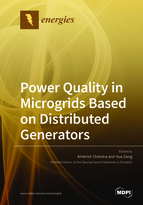Power Quality in Microgrids Based on Distributed Generators
A special issue of Energies (ISSN 1996-1073).
Deadline for manuscript submissions: closed (30 September 2018) | Viewed by 31922
Special Issue Editors
Interests: UPQC; power quality; harmonic compensation; active power filters; statcom; dstatcom; renewable energy; wind energy; solar energy; integration with grid
Special Issues, Collections and Topics in MDPI journals
Interests: power electronics; renewable energy network system; wind power plant; data-driven control on energy systems
Special Issues, Collections and Topics in MDPI journals
Special Issue Information
Dear Colleagues,
This Special Issue of Energy, on “Power Quality in Microgrids Based on Distributed Generators” will be dedicated to new trends in microgrid and related power quality issues. Original unpublished research and application contributions matching the main theme of this Special Issue are welcome. Comprehensive tutorials and survey papers on microgrids and power quality shall be considered for this Special Issue as well. Microgrids are considered as a promising method for integrating various distributed generators (DGs) and loads to provide benefits on the reliability, loss reduction, carbon emission reduction, etc. Power quality is the emerging issue in microgrids, and the problem is more complicated than that in conventional distribution systems because of the intermittent nature of renewable energy sources, as well as the increased infiltration of nonlinear loads and power electronic interfaced DG systems. It can operate either in interconnected and/or in isolated mode from the main distribution grid as a controlled entity. Synchronization between DGs, system efficiency, stability, power quality, ensuring uninterruptible power supply to the connected load, cost reduction, are the some of the main issues for this application.
This Special Issue seeks to promote novel research investigations in microgrid and power quality issues, where authors are encouraged to:
- Address advancement in modeling, designing, analyzing, optimizing and implementing microgrid using different DGs, keeping power quality an important issue, such as, voltage and frequency control, harmonic compensation, and load balancing etc.
- Address resolving issues of microgrid integration into main grid, such as synchronization and stability.
- Investigate microgrids based on AC bus, DC bus, or AC/DC hybrid buses.
- Investigate economical viabilities of many different renewable energy systems for microgrid applications.
- Investigate fault tolerant control and protection of microgrids interfaced with power electronics.
- Investigate the importance of energy storage systems on microgrid requirements and implementation, including the use of non-critical loads for compensating for intermittent nature of renewable energy sources.
- Address advancement in centralized and decentralized control designs for microgrid.
- Write review papers on comparison between different topologies for hybrid renewable energy systems to achieve cost effective and ecosystem friendly solutions and their integration to main grid or for standalone applications.
Prof. Dr. Hua Geng
Guest Editors
Manuscript Submission Information
Manuscripts should be submitted online at www.mdpi.com by registering and logging in to this website. Once you are registered, click here to go to the submission form. Manuscripts can be submitted until the deadline. All submissions that pass pre-check are peer-reviewed. Accepted papers will be published continuously in the journal (as soon as accepted) and will be listed together on the special issue website. Research articles, review articles as well as short communications are invited. For planned papers, a title and short abstract (about 100 words) can be sent to the Editorial Office for announcement on this website.
Submitted manuscripts should not have been published previously, nor be under consideration for publication elsewhere (except conference proceedings papers). All manuscripts are thoroughly refereed through a single-blind peer-review process. A guide for authors and other relevant information for submission of manuscripts is available on the Instructions for Authors page. Energies is an international peer-reviewed open access semimonthly journal published by MDPI.
Please visit the Instructions for Authors page before submitting a manuscript. The Article Processing Charge (APC) for publication in this open access journal is 2600 CHF (Swiss Francs). Submitted papers should be well formatted and use good English. Authors may use MDPI's English editing service prior to publication or during author revisions.
Keywords
- power quality
- microgrid
- renewable energy
- distributed generation
- power electronics
- AC/DC/AC-DC hybrid buses






